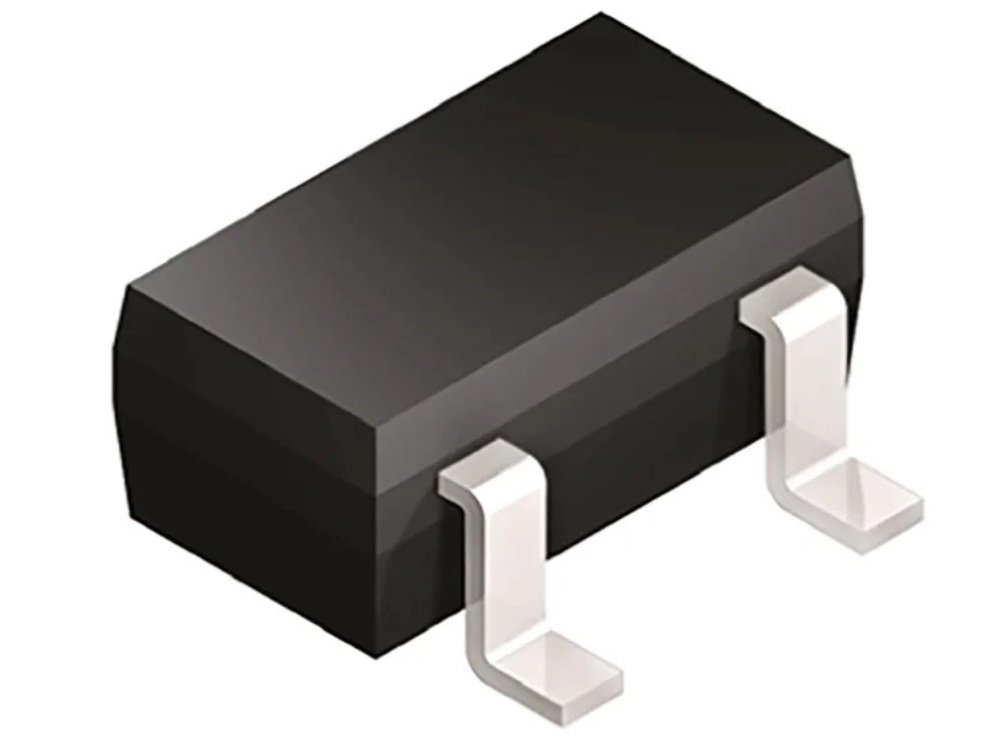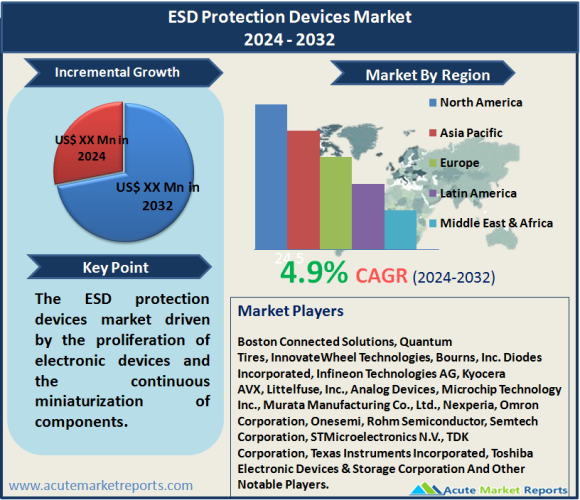
The ESD protection devices market is expected to grow at a CAGR of 4.9% during the forecast period of 2024 to 2032. The market analysis points towards increasing demand for reliable ESD protection solutions across various industries, driven by the proliferation of electronic devices and the continuous miniaturization of components. The market is witnessing a surge in innovations, strategic partnerships, and technological advancements as companies aim to address the escalating challenges posed by electrostatic discharge in electronic circuits. The geographic trends indicate a clear distinction in revenue dominance and growth rates, with North America leading in revenue percentage and the Asia-Pacific region exhibiting the highest CAGR. The competitive landscape underscores a keen focus on innovation, strategic collaborations, and the establishment of robust ecosystems. The top players are not only competing in the present but are actively shaping the future trajectory of the connected tire market. As the industry continues to evolve, it is poised to witness an influx of innovative solutions, creating a paradigm shift in how vehicles interact with their tires and ensuring a safer and more efficient driving experience for consumers worldwide.
Key Market Drivers
Technological Advancements in Semiconductor Manufacturing
The rapid evolution of semiconductor manufacturing processes stands as a pivotal driver for the ESD protection devices market. Advanced technologies, such as sub-10nm semiconductor nodes, have become mainstream, resulting in increased sensitivity to electrostatic discharge. As electronic components become smaller and more intricate, the vulnerability to ESD damage escalates. Industry leaders, including semiconductor manufacturers and ESD protection device suppliers, are investing significantly in research and development to create cutting-edge solutions capable of safeguarding these delicate components. The evidence lies in the numerous patents granted for novel ESD protection designs and the integration of advanced materials, such as carbon nanotubes and graphene, to enhance the efficiency of ESD protection devices in high-performance semiconductor devices.
Proliferation of Internet of Things (IoT) Devices
The proliferation of Internet of Things (IoT) devices across various industries serves as a substantial driver for the ESD protection devices market. With an increasing number of connected devices forming the IoT ecosystem, the risk of ESD-induced failures in these devices becomes a critical concern. The market experiences a surge in demand for ESD protection solutions catering specifically to IoT applications. Evidence supporting this driver includes the rising sales figures of ESD protection devices designed for IoT devices, coupled with the surge in IoT device adoption across sectors such as healthcare, smart homes, and industrial automation. The interconnected nature of IoT necessitates robust ESD protection to ensure the reliability and longevity of these devices, driving the market forward.
Growing Emphasis on Automotive Electronics
The growing emphasis on automotive electronics, encompassing advanced driver-assistance systems (ADAS), infotainment, and electric vehicle components, emerges as a significant driver for the ESD protection devices market. Modern vehicles integrate a multitude of electronic components, making them susceptible to ESD-related issues. Automakers and component suppliers are increasingly incorporating advanced ESD protection devices to enhance the resilience of automotive electronics. The evidence supporting this driver is evident in the strategic collaborations between ESD protection device manufacturers and automotive industry leaders, as well as the incorporation of robust ESD protection measures in the design of next-generation automotive electronic systems. The automotive sector's shift towards electric and autonomous vehicles further accentuates the need for effective ESD protection, driving market growth.

Restraint: Cost Sensitivity in Consumer Electronics
While the ESD protection devices market experiences robust growth, there exists a restraint primarily driven by cost sensitivity, particularly in the consumer electronics segment. Consumers demand cost-effective electronic devices, and manufacturers strive to optimize production costs. This poses a challenge for ESD protection device suppliers, as the integration of advanced ESD protection measures can contribute to overall production costs. Evidence of this restraint is observed in the market dynamics of consumer electronics, where manufacturers often prioritize cost efficiency over incorporating advanced ESD protection technologies. Striking a balance between cost-effectiveness and providing adequate ESD protection remains a challenge, particularly in highly competitive consumer electronics markets.
Market Segmentation Analysis
Market by Material
Silicon-based devices led in terms of revenue in 2023. This is underpinned by their pervasive presence and indispensable role in the semiconductor industry and a myriad of electronic devices. Silicon, with its well-established applications and reliability, stands as the frontrunner in revenue generation. On the flip side, the Highest CAGR during the forecast period is anticipated for Ceramic-based devices. The dynamic growth of Ceramic material can be attributed to its exceptional attributes in meeting the demands of emerging electronic applications and industries.
Market by Technology
The dichotomy between Transient Voltage Suppressor Diodes (TVS) and Multilayer Varistors (MLV) unfolds an intriguing narrative. TVS, with its rapid-response capabilities to voltage spikes, dominated in revenues in 2023. The ubiquitous nature of TVS devices, catering to various electronic circuits requiring swift protection, positions them as revenue leaders. On the other hand, MLV is expected to witness the Highest CAGR. The versatility of MLV technology, coupled with its adoption in applications necessitating effective voltage surge suppression, fuels its higher growth rate.
Market by Directionality
The choice between Uni-directional and Bi-directional ESD protection devices introduces an element of application specificity. Uni-directional devices led the revenues in 2023, particularly in applications where protection is required in a specific orientation. However, the more versatile Bi-directional devices are projected to exhibit the highest CAGR. This underscores their adaptability and suitability for a broader spectrum of applications, driving their accelerated growth.
Market by Protection
The realm of ESD protection encompasses both Data-line and Power-line segments, each vying for prominence in revenue. The diverse needs of electronic circuits contribute to the shared revenue leadership between these two segments. Meanwhile, the Highest CAGR is earmarked for the Power-line protection segment. This can be attributed to the increasing integration of electronic components in power systems and devices, amplifying the need for robust protection mechanisms.
Market by Application
In the year 2023 Antenna Circuit Protection and Audio Circuit Protection dominated the market in terms of revenues. This prominence is propelled by the escalating demand for ESD protection in communication devices and electronic circuits. Conversely, the Highest CAGR is foreseen in the SD/MMC Card Protection and Machine Elements segments. This surge is indicative of the expanding footprint of ESD protection in memory cards and industrial machinery, pointing toward a trajectory of multifaceted growth.
Market by End-use
The end-use spectrum unveiled revenue leadership in the Electronic Devices and Communication Equipment segments for the year 2023. The pervasive integration of ESD protection in consumer electronics and communication devices substantiates this market positioning. Simultaneously, the Highest CAGR is earmarked for the Electric Vehicles segment. This projection mirrors the escalating adoption of ESD protection solutions in the automotive industry's paradigm shift towards electric vehicles, underscoring the evolving dynamics within this sector.
North America Remains the Global Leader
In the expansive landscape of the Connected Tire market, geographic trends play a pivotal role in shaping the industry's dynamics. As of 2023, North America emerged as the region with the highest revenue percentage. This can be attributed to the robust technological infrastructure, early adoption of connected technologies in the automotive sector, and a discerning consumer base. The region's penchant for cutting-edge innovations and the prevalence of high-end vehicles equipped with connected tire solutions contribute significantly to its revenue dominance. Concurrently, the region exhibiting the highest CAGR is the Asia-Pacific (APAC). The burgeoning automotive industry, coupled with a surging demand for advanced safety and monitoring systems, propels the adoption of connected tire technologies in this region. Government initiatives promoting road safety and rapid urbanization contributing to increased vehicle ownership further augment the market growth. APAC's commitment to smart mobility solutions positions it as a frontrunner in terms of growth rate.
Strategic Collaborations to Enhance the Market Share of Top Competitors
Navigating the competitive landscape of the Connected Tire market, key players are strategically positioning themselves to capitalize on emerging opportunities. Noteworthy industry leaders include Boston Connected Solutions, Quantum Tires, InnovateWheel Technologies, Bourns, Inc. Diodes Incorporated, Infineon Technologies AG, Kyocera AVX, Littelfuse, Inc., Analog Devices, Microchip Technology Inc., Murata Manufacturing Co., Ltd., Nexperia, Omron Corporation, Onesemi, Rohm Semiconductor, Semtech Corporation, STMicroelectronics N.V., TDK Corporation, Texas Instruments Incorporated, and Toshiba Electronic Devices & Storage Corporation. These companies are at the forefront, employing a multifaceted approach to consolidate their positions. Strategic partnerships and collaborations are key trends in the market, with established players working with automotive manufacturers to seamlessly integrate connected tire solutions into new vehicle models. Moreover, a common thread among these players is the deployment of Artificial Intelligence (AI) and Internet of Things (IoT) technologies, enabling real-time monitoring of tire conditions, predictive maintenance, and enhanced safety features.
Historical & Forecast Period
This study report represents analysis of each segment from 2022 to 2032 considering 2023 as the base year. Compounded Annual Growth Rate (CAGR) for each of the respective segments estimated for the forecast period of 2024 to 2032.
The current report comprises of quantitative market estimations for each micro market for every geographical region and qualitative market analysis such as micro and macro environment analysis, market trends, competitive intelligence, segment analysis, porters five force model, top winning strategies, top investment markets, emerging trends and technological analysis, case studies, strategic conclusions and recommendations and other key market insights.
Research Methodology
The complete research study was conducted in three phases, namely: secondary research, primary research, and expert panel review. key data point that enables the estimation of ESD Protection Devices market are as follows:
Market forecast was performed through proprietary software that analyzes various qualitative and quantitative factors. Growth rate and CAGR were estimated through intensive secondary and primary research. Data triangulation across various data points provides accuracy across various analyzed market segments in the report. Application of both top down and bottom-up approach for validation of market estimation assures logical, methodical and mathematical consistency of the quantitative data.
| ATTRIBUTE | DETAILS |
|---|---|
| Research Period | 2022-2032 |
| Base Year | 2023 |
| Forecast Period | 2024-2032 |
| Historical Year | 2022 |
| Unit | USD Million |
| Segmentation | |
Material
| |
Technology
| |
Directionality
| |
Protection
| |
Application
| |
End-Use
| |
|
Region Segment (2022-2032; US$ Million)
|
Key questions answered in this report